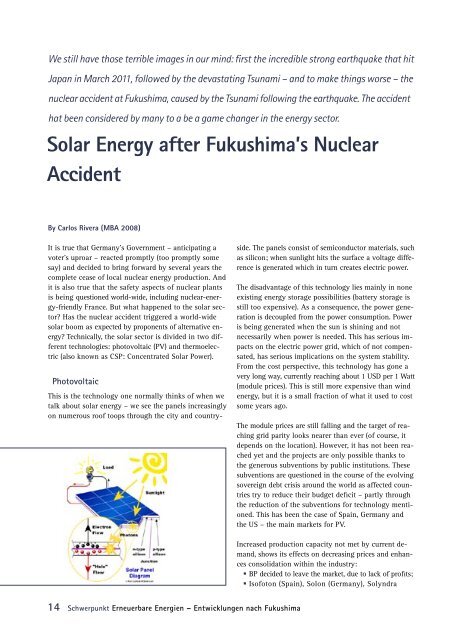Entwicklungen nach Fukushima - ESB-Radler
Entwicklungen nach Fukushima - ESB-Radler
Entwicklungen nach Fukushima - ESB-Radler
Erfolgreiche ePaper selbst erstellen
Machen Sie aus Ihren PDF Publikationen ein blätterbares Flipbook mit unserer einzigartigen Google optimierten e-Paper Software.
We still have those terrible images in our mind: first the incredible strong earthquake that hit<br />
Japan in March 2011, followed by the devastating Tsunami – and to make things worse – the<br />
nuclear accident at <strong>Fukushima</strong>, caused by the Tsunami following the earthquake. The accident<br />
hat been considered by many to a be a game changer in the energy sector.<br />
Solar Energy after <strong>Fukushima</strong>’s Nuclear<br />
Accident<br />
By Carlos Rivera (MBA 2008)<br />
It is true that Germany’s Government – anticipating a<br />
voter’s uproar – reacted promptly (too promptly some<br />
say) and decided to bring forward by several years the<br />
complete cease of local nuclear energy production. And<br />
it is also true that the safety aspects of nuclear plants<br />
is being questioned world-wide, including nuclear-energy-friendly<br />
France. But what happened to the solar sector?<br />
Has the nuclear accident triggered a world-wide<br />
solar boom as expected by proponents of alternative energy?<br />
Technically, the solar sector is divided in two different<br />
technologies: photovoltaic (PV) and thermoelectric<br />
(also known as CSP: Concentrated Solar Power).<br />
Photovoltaic<br />
This is the technology one normally thinks of when we<br />
talk about solar energy – we see the panels increasingly<br />
on numerous roof toops through the city and country-<br />
14 Schwerpunkt Erneuerbare Energien – <strong>Entwicklungen</strong> <strong>nach</strong> <strong>Fukushima</strong><br />
side. The panels consist of semiconductor materials, such<br />
as silicon; when sunlight hits the surface a voltage difference<br />
is generated which in turn creates electric power.<br />
The disadvantage of this technology lies mainly in none<br />
existing energy storage possibilities (battery storage is<br />
still too expensive). As a consequence, the power generation<br />
is decoupled from the power consumption. Power<br />
is being generated when the sun is shining and not<br />
necessarily when power is needed. This has serious impacts<br />
on the electric power grid, which of not compensated,<br />
has serious implications on the system stability.<br />
From the cost perspective, this technology has gone a<br />
very long way, currently reaching about 1 USD per 1 Watt<br />
(module prices). This is still more expensive than wind<br />
energy, but it is a small fraction of what it used to cost<br />
some years ago.<br />
The module prices are still falling and the target of reaching<br />
grid parity looks nearer than ever (of course, it<br />
depends on the location). However, it has not been reached<br />
yet and the projects are only possible thanks to<br />
the generous subventions by public institutions. These<br />
subventions are questioned in the course of the evolving<br />
sovereign debt crisis around the world as affected countries<br />
try to reduce their budget deficit – partly through<br />
the reduction of the subventions for technology mentioned.<br />
This has been the case of Spain, Germany and<br />
the US – the main markets for PV.<br />
Increased production capacity not met by current demand,<br />
shows its effects on decreasing prices and enhances<br />
consolidation within the industry:<br />
ß BP decided to leave the market, due to lack of profits;<br />
ß Isofoton (Spain), Solon (Germany), Solyndra






